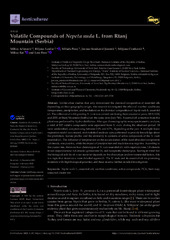| dc.creator | Aćimović, Milica | |
| dc.creator | Lončar, Biljana | |
| dc.creator | Pezo, Milada | |
| dc.creator | Stanković Jeremić, Jovana | |
| dc.creator | Cvetković, Mirjana | |
| dc.creator | Rat, Milica | |
| dc.creator | Pezo, Lato | |
| dc.date.accessioned | 2022-02-10T11:33:38Z | |
| dc.date.available | 2022-02-10T11:33:38Z | |
| dc.date.issued | 2022 | |
| dc.identifier.issn | 2311-7524 | |
| dc.identifier.uri | http://fiver.ifvcns.rs/handle/123456789/2486 | |
| dc.description.abstract | Unlike other studies that only determined the chemical composition of essential oils depending on their geographic origin, this research investigated the effect of weather conditions (temperature, precipitation, and insolation) on the chemical composition of Nepeta nuda L. essential oil. The collection of wild-growing N. nuda was carried out during three successive years, 2019, 2020, and 2021 at Rtanj Mountain (Serbia) on the same date (July 7th). Essential oil extraction from the plant was performed by hydro-distillation. After gas chromatographic-mass spectrometric analysis, a total of 102 volatile compounds were separated from N. nuda, during the observed period, 28 were unidentified, compromising between 5.0% and 8.7%, depending on the year. A multiple linear regression model was created, and statistical analyses were performed to provide knowledge about the prediction, feature profile, and the similarity in contents of active compounds of the N. nuda essential oil. The influence of temperature on the accumulation of the most abundant component, 1,8-cineole, was positive, while the impact of precipitation and insolation was negative. According to the cluster tree, there are four chemotypes of N. nuda essential oil: with nepetalactone, 1,8-cineole, mixed (nepetalactone+1,8-cineole+germacrene D), and nonspecific chemotypes. Bearing in mind that the biological activity of a raw material depends on the chemotype and environmental factors, this is a topic that deserves a more detailed approach. The N. nuda and its essential oil are promising materials with high biological potential, and these deserve further detailed investigation. | sr |
| dc.language.iso | en | sr |
| dc.publisher | Basel : MDPI | sr |
| dc.relation | info:eu-repo/grantAgreement/MESTD/inst-2020/200051/RS// | sr |
| dc.relation | info:eu-repo/grantAgreement/MESTD/inst-2020/200012/RS// | sr |
| dc.relation | info:eu-repo/grantAgreement/MESTD/inst-2020/200032/RS// | sr |
| dc.relation | info:eu-repo/grantAgreement/MESTD/inst-2020/200134/RS// | sr |
| dc.relation | info:eu-repo/grantAgreement/MESTD/inst-2020/200125/RS// | sr |
| dc.relation | info:eu-repo/grantAgreement/MESTD/inst-2020/200026/RS// | sr |
| dc.rights | openAccess | sr |
| dc.rights.uri | https://creativecommons.org/licenses/by/4.0/ | |
| dc.source | Horticulturae | sr |
| dc.subject | Nepeta nuda L. | sr |
| dc.subject | essential oils | sr |
| dc.subject | weather conditions | sr |
| dc.subject | active compounds | sr |
| dc.subject | PCA | sr |
| dc.subject | heat map | sr |
| dc.subject | unrooted cluster tree | sr |
| dc.title | Volatile compounds of Nepeta nuda L. from Rtanj Mountain (Serbia) | sr |
| dc.type | article | sr |
| dc.rights.license | BY | sr |
| dc.citation.rank | M21 | |
| dc.citation.spage | 85 | |
| dc.citation.volume | 8 | |
| dc.identifier.doi | 10.3390/horticulturae8020085 | |
| dc.identifier.fulltext | http://fiver.ifvcns.rs/bitstream/id/6803/horticulturae-08-00085.pdf | |
| dc.identifier.scopus | 2-s2.0-85124469851 | |
| dc.identifier.wos | 00079801850000 | |
| dc.type.version | publishedVersion | sr |


